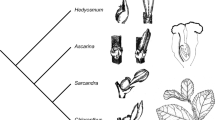Abstract.
An evolutionary pathway leading to acrotonous, 2-flowered spikelets of Panicoideae has been suggested elsewhere, which involves apical reduction of many-flowered mesotonic spikelets. Current phylogenies of the grass family show a sister relationship between Panicoideae and Centothecoideae. A survey of spikelet structures occurring among centothecoid grasses shows that some representatives of this group have intermediate morphologies which are consistent with that hypothesis. Chasmanthium and Bromuniola have many-flowered spikelets with a barren proximal floret, whereas Thysanolaena, Gouldochloa and Gynerium represent a series of apical reductions leading to 2-flowered spikelets. Moreover, many-flowered spikelets with 1-3 proximal male flowers followed by several female-fertile ones occur in Puelioideae, one of the early-diverging clades of the Poaceae. This fact suggests that some “panicoid” characters may have evolved long before the radiation of the Panicoideae took place.
Similar content being viewed by others
Author information
Authors and Affiliations
Corresponding author
Additional information
I am grateful to J. G. Sánchez-Ken for valuable comments on the manuscript, and to J. Cámara-Hernández and R. D. Tortosa for critical review. I am also indebted to the curators of BAA, K, and SI for making the herbarium material available. This research was supported by the grant UBACyT AG-027, from the Buenos Aires University.
Rights and permissions
About this article
Cite this article
Rua, G. Centothecoid grasses and the evolution of panicoid spikelets. Plant Syst. Evol. 240, 83–89 (2003). https://doi.org/10.1007/s00606-003-0017-y
Received:
Published:
Issue Date:
DOI: https://doi.org/10.1007/s00606-003-0017-y




